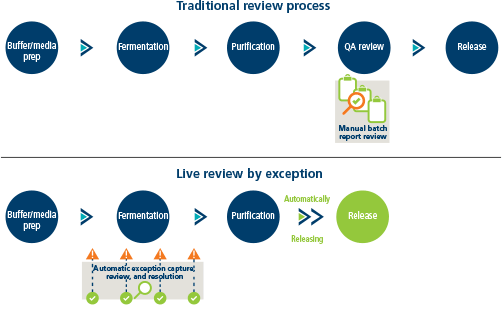- By Emilee Cook
- Features
Summary
Three strategies help life sciences companies implement more successful review by exception
By Emilee Cook

One large, global biopharmaceutical manufacturer has begun to improve operations performance by implementing a live review-by-exception (RBE) process. The process is integrated into the plant’s production review and allows the plant’s quality assurance (QA) team to identify process deviations and their severity as they occur. Previous approaches required waiting for a batch to complete, and then reviewing all exceptions line by line.
The organization focused on three strategies to make sure a shift away from paper records toward live digital RBE would deliver the desired results. By expanding automation to empower employees, building staff support with user-friendly solutions, and standardizing technology for fast return on investment (ROI), the QA team accomplished a 200 percent ROI in the first month after implementing live RBE.
Expand automation to empower employees
Before the biotech organization implemented RBE, a typical batch release took three to four weeks to complete. The QA team ran a batch report—typically hundreds of pages long—and reviewed, logged, and manually cleared each exception. Batches were held until review completion, making the cumbersome manual review process a bottleneck for timely release.
Streamlining batches with review by exception
Moving to RBE digitalized and automated many of the steps necessary to safely improve and expedite batch releases. Now, within 10 minutes of an exception, the software identifies it, logs it, and notifies the team. With faster notification of exceptions, QA personnel can fix problems faster, and track patterns to identify process problems and eliminate them earlier.
Right after implementing RBE, the team identified a problem with a salt feeder not responding properly. Fixing the problem required an operator to manually open and close a butterfly valve. This manual intervention created more than 150 exceptions for each buffer prep application. Once the team began using RBE, another exception was identified almost immediately.
These fast alerts enabled a quick response, which in turn helped QA isolate and diagnose the root cause. The QA team changed the feed mechanism, ultimately improving the quality of the buffer solution. The change also improved efficiency, as the operator was no longer required to manually adjust the valve.
Digitalization of the review process has allowed the QA team to safely auto-release 50–60 percent of batches immediately after completion (figure 1). Average batch release time went from four weeks to six hours.

The organization saved millions of dollars in finished goods inventory, and QA personnel gained more time to focus on manufacturing performance and product quality.
Build staff support with user-friendly solutions
Before implementing RBE, QA personnel were frustrated with the time it took to manage exceptions, with manual logging taking upward of 15 minutes per exception. Logging also required manually annotating exceptions with essential metadata—key performance indicators, quality attributes, and variables—to provide the full context of the production process around the exception. Because the process was so complex, the team typically had to run the batch reports multiple times to ensure they caught all the exceptions.
Automation systems handle the busywork
The live exception notifications available in the RBE process helps the team release batches in hours rather than weeks. Having a live RBE system integrated with the organization’s production review not only identifies exceptions, but also helps the QA team resolve them.
Exceptions delivered by the RBE system come with a severity level and associated resolution process. For example, a high severity exception might require a staged process including an operator signature, QA review signature, QA verifier signature, and management-level signature. The live RBE software automatically guides this process, so QA members do not have to spend time searching for people in the plant and gathering information and signatures manually. Not only does RBE identify exceptions automatically, it also logs them and records all necessary metadata as the event occurs, helping with batch record accuracy and efficiency.

Personnel quickly embraced the digital transformation of batch review, because it made their jobs easier. Operators no longer spend time logging exceptions; they simply record a comment and move on. They also have more accurate records, making it easier to trend production problems and quickly identify solutions.
Now, the majority of exceptions are cleared by the time a batch is finished. QA team members collaborate live on the floor with operators using tablets with RBE software installed to view and resolve exceptions. Both QA members and operators can add comments and answer questions, significantly shortening the time it takes to reach resolution.
Standardize technology for fast ROI
The QA team has created a dashboard showing open and close times for exceptions. The team has visibility to the work that needs to be done and can quickly resolve exceptions and return its attention to any manufacturing quality issues. The constant visible reminder of the increased performance and efficiency has generated a significant morale boost.
When the QA team initially considered digital transformation of their processes, they planned to write and build a custom RBE application. Fortunately, before they began that process, they were introduced to an existing RBE solution designed to integrate with the existing manufacturing execution system (MES) and distributed control system (DCS).
Choosing a solution specifically designed to work with the existing MES and DCS benefited the team in several ways. It required no additional complex engineering, because it seamlessly integrated with the organization’s MES and DCS. This reduced the project time and made the RBE system easier to maintain over its life cycle. The team also pulled alarms and OPC exceptions into the RBE system in real time, helping them stay better informed.
The software also uses an interface already familiar to plant personnel, as it is similar to the MES and DCS interface, so it is easy for users to understand how to incorporate it into existing practices. The plant had planned a four-month adoption curve for RBE, but personnel were already comfortably using the system after only two weeks.
Faster implementation means faster benefits, with the team seeing a 200 percent ROI in the first month after implementation of the RBE. In addition, the QA team has moved away from addressing exceptions and back toward a focus on reducing manufacturing issues, resulting in better quality and increased performance across the plant.
RBE technologies operate directly at the intersection of automation and personnel to help plants make the efficiency gains necessary to improve processes and dramatically cut release times. When an RBE system empowers personnel and smoothly integrates with existing tools, operators not only perform their tasks with more confidence, but also have the process history and task flexibility to focus on other critical issues affecting performance and quality. In addition, digitalized production boosts morale and increases collaboration among plant personnel, improving the overall plant experience for operators, QA team members, and other plant staff.
All these benefits helped the biotechnology manufacturer rapidly expand and evolve to meet the demands of patients facing newly discovered illnesses. Digitally transforming processes using technologies such as RBE is critical to meeting these needs quickly. Digitalized production ensures plants can quickly, easily, and safely scale production up or down without affecting quality or performance.
Reader Feedback
We want to hear from you! Please send us your comments and questions about this topic to InTechmagazine@isa.org.


